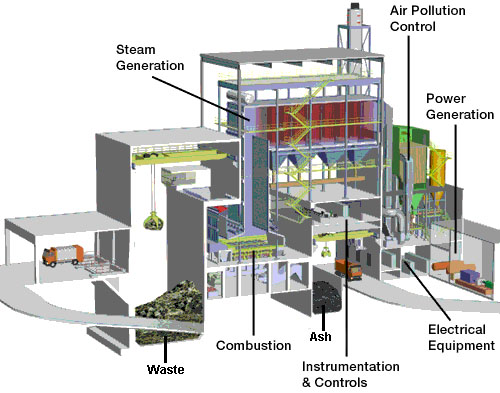SOURCE: JUAN WILSON juanwilson@mac.com
POSTED: 10 MAY 2007 - 8:00am HST
Waste to Energy (WTE) is a boondoggle

cutaway diagram of a large scale WTE plant from ABB Enertech web site
by Juan Wilson on 10 May 2007 Waste to Energy (WTE) can be a good idea. One of the best WTE processes is the capturing methane gas created by the anaerobic breakdown of garbage inside a landfill. Methane is a clean fuel and if left to escape into the atmosphere, a potent greenhouse gas (more so than carbon dioxide). Capturing landfill methane is easy, passive and kills two birds with one stone - reducing global warming while providing clean energy. The KIUC Waste to Energy Plan (WTE) , announced a year ago is to KIUC to simplyburn garbage as a way of producing electricity. The plan is a pork barrel project. Millions of dollars of public funds will be spent. A private conteactor will get richer. We will own a smoking white elephant. Burning garbage is a messy technology at best. KIUC WTE proposal is in reality an avoidance of several converging problems that need to be dealt with by adjusting our lifestyles. Some of those problems are 1) The end of the lifespan of our landfill, and inability to find a new site 2) The high rate of energy use and cost of imported fuel 3) The high rate of consumption and waste production
5) The failure of our sugarcane economy and use of its infrastructure
Reduction in consumption is the single greatest factor in dealing with these problems. In addition, governement economic incentives to reduce the waste stream and recycle more would have a positive effect too. Building a plant to burn energy will be an incentive to produce more trash.
The British Clean Coal Centre states - "The SNCR process can produce nitrous oxide (N2O), which contributes to the greenhouse effect. N2O formation resulting from SNCR depends upon the reagent used, the amount of reagent injected and the injection temperature." It seems to me that the last thing Kauai needs to do in "solving" the energy problem is to increase greenhouse gases escaping. Not only that, the ash and unburned residue from trash combustion is more hazardous than the trash itself. Incineration produces fly ash and bottom ash just as is the case when coal is combusted. "The total amount of ash produced by municipal solid waste incineration ranges from 15% to 25% by weight of the original quantity of waste, and the fly ash amounts to about 10% to 20% of the total ash. The fly ash, by far, constitutes more of a potential health hazard than does the bottom ash because the fly ash contains toxic metals such as lead, cadmium, copper and zinc as well as small amounts of dioxins and furans. The bottom ash may or may not contain significant levels of health hazardous materials. In the United States, and perhaps in other countries as well, the law requires that the ash be tested for toxicity before disposal in landfills. If the ash is found to be hazardous, it can only be disposed of in landfills which are carefully designed to prevent pollutants in the ash from leaching into underground aquifers. In testing over the past decade, no ash from a U.S. modern waste-to-energy plant has ever been determined to be a hazardous waste." from the Wikipedia |
see also:
Island Breath: KIUC Board Election 3/19/2007
Island Breath: Makini Uwila "GridBuster" 12/18/2006
Island Breath: Wind Power in Limbo 6/2/2006
Island Breath: KIUC = ENRON 12/11/2005
Island Breath: KIUC sunshine policy 11/27/2005
Island Breath: KIUC spending expose 10/31/2005
Island Breath: KIUC should pay us for power 8/26/2004
Island Breath:They call this cooperative? 7/21/2004